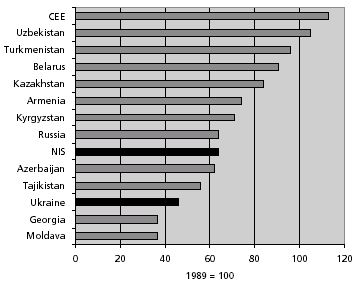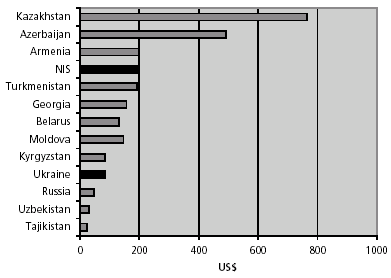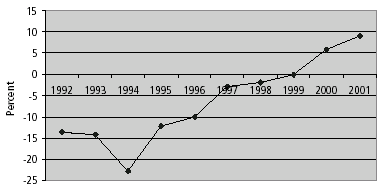|
Environment in Ukraine - Problems and Challenges 2. Environmental Policy in Transition2.1 IntroductionUkraine is a middle-income country situated in Eastern Europe. It will become a direct neighbour to the EU following the forthcoming EU enlargement. Today, the country finds itself midst in a most difficult transition towards democracy and market economy. This transition affects all spheres of the society. Environmental policy is no exception. Environmental related problems are tremendous. They have accumulated over a long period of time. Though the output decline throughout the 90’s has improved environmental performance, to some extent, several developments have worsened environmental performance. One of these developments is the decline in investments in environmental infrastructure. In fact, there have been no major investments in environmental infrastructure since the 60’s and 70’s. Consequently, numerous ticking environmental bombs do exist in Ukraine. The Ukrainian Government has acknowledged this. The Ministry of Environment and Natural Resources (MENR) has been made overall responsible for the development and implementation of environmental policies in line with international standards. The NEAP for Ukraine was approved in 1998 as part of the so-called "Environment for Europe" process, and the NEHAP for Ukraine was approved in 1999. Furthermore, various, more or less comprehensive environmental policy reform initiatives have been launched during the last decade. In this chapter we provide an overview of the existing room of manoeuvre for the authorities, enterprises and NGOs in Ukraine when dealing with the environmental related problems and challenges within the water, waste and energy sectors to be outlined in Chapter 3. Section 2.2 concerns the macro economic developments, whereas Sections 2.3-2.6 deal with the international environmental agreements, environmental management set-up, public environmental expenditure and major environmental policy reform initiatives, respectively. 2.2 Macro Economic DevelopmentsUkraine is to some extent comparable to France. Its population totals 49 million inhabitants, and it covers an area of 604,000 km2. The corresponding figures for France are 58.6 million and 552,000 km2. But –Ukraine and France differ in many other respects. The GDP of Ukraine amounts to less than 3 per cent of France’s. Ukraine has experienced an immense output decline since it gained independence in 1991, even in comparison with other NIS countries. The level of real GDP in 2001 was only an estimated 46 per cent of the level of real GDP in 1989. For comparison the same figure was an estimated 64 per cent for Russia. The output decline has been accompanied by an increase in the service sector’s share of GDP, exports and inequality. The level of inequality as measured by the so-called Gini coefficient has nearly doubled from late 80’s till late 90’s.
Figure 2.1
Total investments, including investments in environmental infrastructure, have declined substantially, whereas capital flight has increased. As a result the average age of machinery and equipment has increased throughout the economy. Furthermore, foreign investors have not shown any particular interest in coming to Ukraine. FDI inflows to Ukraine have been anything but impressive. The cumulative FDI inflows per capita during 1989-2001 amounted to only US$ 84. It was more than the corresponding figure for Russia (US$ 47), but less than the average figure for the NIS (US$ 196). The cumulative FDI inflows per capita during 1989-2001 have been many times higher for Lithuania (US$ 813), Latvia (US$1,138) and Estonia (US$ 1,727). Basically, the total investments decline and also the low level of FDI inflows in Ukraine reflects the inability of the Ukrainian Government to provide some basic public goods, such as a legal and judicial system capable of enforcing contracts and property rights, a macro economy that ensures stability over time and a banking system that provides effective financial intermediation. Only very few investors are risk lovers.
Figure 2.2
In recent years, however, Ukraine has experienced positive growth rates for the first time since 1989. The growth in real GDP amounted to 5.9 per cent in 2000 and an estimated 9.1 per cent in 2001. In 2002, the growth rate in real GDP amounted to an estimated 4.1 per cent. Especially, return of growth in the Russian economy and the depreciation of the UAH in 1999 impacted positively on the economic performance of Ukraine. Has the economic recovery occurred?
Figure 2.3
Certainly, macroeconomic performance has improved in recent years. Other economic key indicators such as the consumer price index have improved considerably as well during the last two-three years. It is, however, not yet possible to state that an economic recovery has ccurred. In fact, many key reforms, including structural reforms, are still pending. Thus, prospects are uncertain. Most important is that the privatisation process has not yet been completed. It is foremost a problem with regard to privatisation of large-scale enterprises, including major utilities within the energy sector, to strategic investors. In fact, Ukraine lags very much behind Russia in the privatisation process. Furthermore, tunnelling and rent seeking, which are rooted in serious imbalances in the reform process and also in the continuing privatisation process, are still profound. Tunnelling is the legal expropriation of income and assets belonging to minority stakeholders. Rent seeking refers to the efforts of enterprises to obtain advantages through privileges or subsidies granted by the authorities. 2.3 International Environmental AgreementsThroughout the 90’s Ukraine has signed or ratified a number of international environmental agreements, which oblige Ukraine to certain actions. Ukraine is a party to 26 international environmental agreements. Furthermore, the country has signed more than 70 bilateral and regional agreements in the fields of environmental protection and nuclear safety. It is a party to regional environmental agreements concerning the Black Sea, Azov Sea and Carpathians. These agreements are often referred to in Ukraine. Table 2.1
There is, however, one international agreement, which presently seems to be the most important international agreement in the field of environmental protection, insofar as it is on the top of the agenda of President Kuchma and also the Ukrainian Government. That is the Partnership and Co-operation Agreement (PCA) between the EU and Ukraine, which was signed on 14 June 1994 and entered into force on 1 March 1998. Though it is not considered an international environmental agreement, it touches upon environmental policy. The PCA is seen as an important instrument in bringing Ukraine in line with the legal frameworks of the single European market and the WTO system. Most important with regard to environmental policy is Article 51, which calls for approximation of laws, including environmental laws and regulations, and Article 63, which obliges the parties to solve a number of environmental problems. In June 1998, President Kuchma adopted a decree, titled "On the Strategy for Ukraine’s Integration into the European Union". It states that "the main priority of Ukraine’s foreign policy in the medium term is the attainment of associate member status in the EU1 and envisages the approximation of Ukrainian economic, social and environmental legislation to the standards required of countries applying for admission to the EU . In December 1999, the Helsinki European Council adopted an EU Common Strategy on Ukraine. It aims at developing a strategic partnership between the EU and Ukraine on the basis of the PCA, while welcoming the country’s outspoken European choice. Virtually all environmental EU Directives are relevant to Ukraine following the PCA and subsequent documents, strategies and statements. These include the Water Framework Directive, Urban Waste Water Treatment Directive, Waste and Hazardous Waste Framework Directive, Landfill Directive, Packaging Waste Directive, Air Quality Framework Directive, EIA Directive and IPPC Directive.
2.4 Environmental Management Set-upUkraine operates under a unitary system of government, although it has some characteristics of a federal state. In addition to the national government, there are 27 regional governments and a large number of lower level governments. Ukraine consists of 27 regions, including 24 so-called oblast’s (counties), the Autonomous Republic of Crimea and the cities of Kiev and Sevastopol. The environmental management set-up may be described by looking upon the legal and regulatory frameworks separately as we do in the following. 2.4.1 Legal framework The present legal framework for environmental management was established by the Law of Ukraine "On Environmental Protection" adopted by the Parliament on 25 June 1991. This is the main environmental law. It has subsequently been further detailed in four Codes – Land Code (1992), Forest Code (1994), Mineral Resources Code (1994) and Water Code (1995) – eight laws, more than 30 resolutions of the Cabinet of Ministers and several decrees, normative acts and other regulations. Today, environmental legislation in Ukraine consists of more than 200 laws and regulations. The hierarchy of these is as follows: Constitution of Ukraine; laws, codes and international agreements adopted by Parliament; Presidential decrees; decrees or resolutions adopted by the Parliament; resolutions of the Cabinet of Ministers; normative acts and other regulations issued by the ministries and state committees; and normative acts and other regulations adopted by the regional governments or regional legislative bodies. However, law enforcement is weak. Most environmental legislation does not work as intended in practice. This is, to some extent, a result of the characteristic features of the present legal framework for environmental management. Characteristic features of the present legal framework are the following:
The NEAP for Ukraine was approved in 1998. It was meant as an action programme guiding authorities, enterprises and NGO’s in their attempt to improve environmental performance. But it has proved to be nothing but a declaration. The NEAP for Ukraine consists of various documents. These are the following:
The reason why the NEAP has proved to be nothing but a declaration is two-fold. First, financing has been insufficient. Many state programmes have only been carried out to a very limited degree. Second, the NEAP itself suffers from serious weaknesses, which made it almost impossible to implement it, even if financing was sufficient. The last mentioned reason is the main reason.
The NEAP vaguely refers to the concept "sustainable development". Its exact meaning in Ukraine is, however, still very unclear to the authorities. In August 2002, a concept paper on sustainable development prepared by the Ukrainian Government was passed on to President Kuchma for his consideration. 2.4.2 Regulatory framework The present regulatory framework for environmental management has evolved since the adoption of the Law of Ukraine "On Environmental Protection" in 1991. Characteristic features of the present regulatory framework are the following:
Table 2.3
2.5 Public Environmental ExpenditureEnvironmental expenditures are low in comparison with EU countries, foremost measured in monetary terms. They amount to an estimated one per cent of GDP, which is one-two per cent-points lower than in the EU countries. It is, however, very difficult to make such a comparison because Ukraine has not yet introduced the methodology used by the Eurostat and OECD for calculating environmental expenditure (the pollution abatement and control methodology). Environmental expenditure, measured in fixed prices, has decreased throughout the 90’s. Environmental investment expenditure has decreased the most – by more than 50 per cent according to official data. Public budgets, environmental funds and enterprises’ own financial sources constitute the domestic sources for environmental financing. The most important domestic source is enterprises’ own financial sources; they account for 60-70 per cent of domestic funding. Foreign financial sources play a limited role within environmental financing. In 2001, public environmental expenditure amounted to UAH 596 million, corresponding to US$ 113 million, US$ 2.3 per capita or 0.3 per cent of GDP. The lions share was current expenditure, not investment expenditure. The public budgets at all levels (national, regional and local) accounted for 83 per cent of public environmental expenditure, whereas the environmental funds, which in recent years have been consolidated into the public budgets, accounted for the remaining 17 per cent. The National Environmental Fund accounted for UAH 57 million, and the regional and local funds accounted for UAH 43 million. Public environmental expenditure is covered through various specially designed economic instruments in the field of environmental protection. They mainly serve the purpose of raising revenues to the public budgets and environmental funds. So far, their behavioural effects have not been in focus. These specially designed economic instruments comprise:
The pollution charges and also most of the penalties and fines for noncompliance go to the environmental funds (30 per cent to the National Environmental Fund, 50 per cent to the regional environmental funds and 20 per cent for the local environmental funds). The other revenues go directly to the public budgets. In recent years, the environmental fund system has undergone important changes. Today, the environmental fund system consists of the National Environmental Fund, 27 regional environmental funds and approximately 1400 local environmental funds. The MENR is presently preparing, together with the Cabinet of Ministers and Ministry of Finance, a draft Law on the National Environmental Fund to be submitted to the Parliament for consideration. 2.6 Major Environmental Policy Reform InitiativesPresently, there are various ongoing major environmental policy reform initiatives in Ukraine within the water, waste and energy sectors. 2.6.1 Water In January 2002, the Parliament adopted a state programme for water sector development to be implemented in two phases (2002-2006 and 2006-2011). The program aims at improving drinking water quality, promoting environmental friendly usage of water resources, including optimisation of water balances, and ensuring proper protection and restoration of water resources. The number of environmental quality standards and effluent limit values within the water sector has been substantially reduced during the last couple of years. They have also been changed. Still, however, they do not comply with the EU standards. Furthermore, many of these are not yet implemented; for instance the new environmental quality standards launched in 1999 by the Ministry of Health in its action plan on potable water standards have not yet been implemented. It is envisaged that the MENR in the near future will take the lead in ensuring that they will be further revised to comply with the EU standards. Taking into account various environmental EU Directives, it is planned to:
A National Water Sector Strategy and Action Plan for Ukraine is being prepared with support from the DANCEE. It deals with technical improvements and changes in the legal and regulatory frameworks within the water sector. 2.6.2 Waste A draft Waste Code has been elaborated and submitted to the Parliament for consideration. It is foreseen that the forthcoming Waste Code to be adopted by the Parliament in 2003 will codify the legislation in the area of waste management. The draft Waste Code embraces the Laws of Ukraine "On Waste", "On Scrap Metal" and "On National Hazardous Waste Management Program", various resolutions, instructions and other regulations of the Cabinet of Ministers and also regulations prepared by various departments within ministries and state committees. It proposes, among others, the introduction of waste fees levied directly on waste producers with the purpose of increasing revenues for waste management. It has caused many remarks from, especially, the industry. The Cabinet of Ministers has elaborated and submitted to the Parliament for consideration draft Laws of Ukraine "On Ecological Insurance" and "On Ecological Audit". It is envisaged that these two laws will be adopted in 2003. Existing environmental legislation includes provisions to require source separation of waste by enterprises and households. Furthermore, it includes provisions regarding waste minimisation, through waste generation norms per unit of produced product, including the consumption of raw materials and energy. It is being considered by the MENR how to put these provisions into force.
In the near future it is planned to:
2.6.3 Energy The energy sector reform is high on the political agenda. It has not yet been completed, but important steps forward have been made or are underway. The reform was initiated in 1994. It included corporatisation of the industry or industry unbundling – both vertically (generation, transmission and distribution) and horizontally (separate companies within generation and distribution). Since then substantial progress has been made regarding commercialisation of the industry, establishment of regulatory authorities and also tariff reform. Especially, electricity tariffs have been gradually increased. However, further increases in electricity tariffs are ahead; these will mainly affect residential consumers, who so far have been cross-subsidised by industrial users. Most important is that the privatisation, which reduces the government’s commercial role in the energy sector, has begun. In particular, many power generation and distribution companies have been privatised in recent years. Even foreign investors have been allowed to participate in the privatisation. In November 2001, five power distribution companies were privatised – two to the American utility AES and three to a utility from the Slovak Republic. The Ukrainian Government intends to proceed with the sale of controlling stakes to strategic investors in the regional power distribution companies that remain under state ownership and also to proceed with the sale of its remaining stakes in the power companies that have already been privatised. This further privatisation has, however, been delayed for various reasons, including the yet unsolved debt problems of the regional power distribution companies. In 2002, agreements were finally made between Ukraine and its two energy supplying countries, Russia and Turkmenistan, on accumulated debts and future payments. Furthermore, Ukraine’s national gas company, Naftohaz Ukrainy, signed a package of agreements with Russia’s gas monopoly, Gazprom, which, among others, makes Gazprom the operator of Turkmen gas transit to Ukraine. These agreements are important insofar as they make it possible for the Ukrainian Government and also the regulatory authorities within the energy sector to concentrate on the successful finalisation of the energy sector reform. According to recent official statements, the Ukrainian Government and the regulatory authorities within the energy sector in the near future plan to:
|


